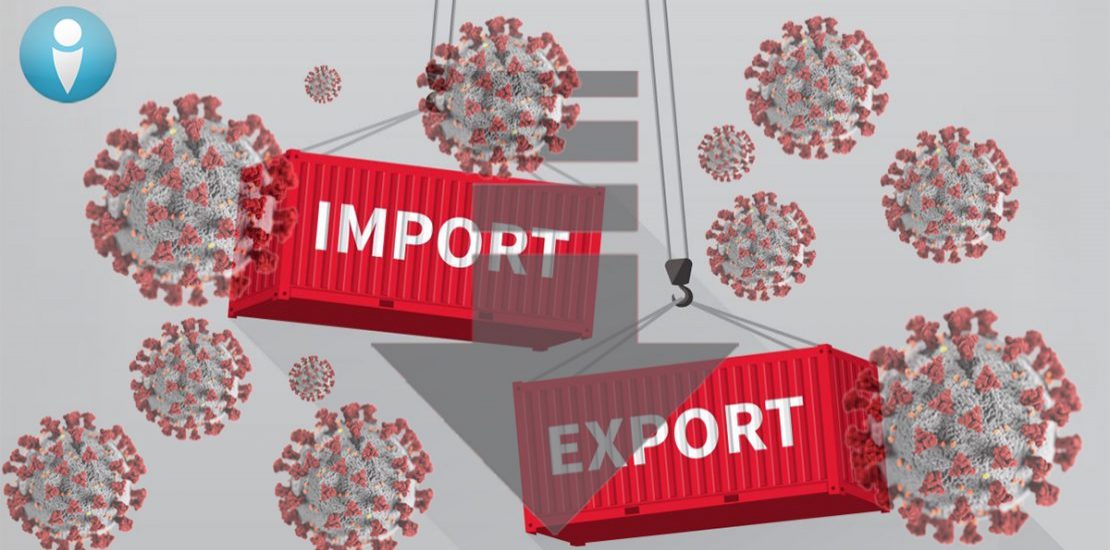- 21 July, 2020
- Economy and Energy

The year 2020 started with the COVID-19 pandemic all over the world. It first forced China, then the rest of the world, to impose restrictions on almost every sector of the economy. Armenia was not an exception – a state of emergency was declared in the country in mid-March, which is still maintained.
These restrictions had a significant impact on the economy, particularly on foreign trade.
Impact on exports
In January only a number of countries were witnessing the effects of the virus, whereas starting from February the negative effects began to be noticed in Armenia as well.
The proof of that is that in January 2020 the export exceeded the index of January 2019 by more than 20% (which was a result of the general economic growth). From February, however, it began to decline; already in March (after the decision on the state of emergency) exports began to decline significantly in comparison with the exports in 2019.
The decline in exports continued in April – by about 28.5% compared to the previous year.
According to the data published by the RA Statistical Committee, the decline in exports in May continues, but not at the same pace as in previous months. In May 2020, more than $ 192 million worth of products were exported from Armenia, which is about 16 million or 7.8% less than in May 2019.
Export geography
In the first 5 months of this year, products worth about $ 886 million were exported from Armenia. For comparison it should be noted that compared to the same period last year, this figure decreased by about 78 million dollars or 8․1%. Through January-May 2019, products worth $ 964 million were exported from Armenia.
25% of the goods ($ 221.6 million) are exported to the EEU member states, and here, of course, the largest partner is the Russian Federation. 24․1% of Armenian goods ($ 213․2 million) were exported to this country. In the same period last year, exports to the EEU member states accounted for 26.7% of exports ($ 257.3 million), and to Russia – 25.9% ($ 249-5 million).
Alcoholic beverages, tobacco, ready-made food, textile products, fruits and vegetables, and a namber of other products continue to dominate among the goods exported from Armenia to Russia and to other EEU countries.
Exports to EU member states have also declined. This year, products worth $ 180.5 million (20․4%) were exported to EU member states, while in the same period last year, products worth $ 226․3 million (23․5%) were exported in this direction.
The main trade partners of Armenia from the EU member states are Bulgaria – 71․3 million dollars (8%), the Netherlands – 49․4 million dollars (5․6%), Germany – 20․4 million dollars (2․3%), Italy – 13․9 million dollars (1․6%) and Belgium – 12․1 million dollars (1․4%).
With the exception of Bulgaria, where the volume of exported goods increased by 6․3 percentage, exports to other European countries decreased significantly compared to January-May 2019.
The main products exported from Armenia to these countries are precious and semi-precious stones, metals and items made of them, as well as textile items, etc.
If in the first 5 months of last year 48.5% of the goods exported from Armenia went to non-EEU and non-EU countries, this year more than half of the goods – 53.3% – have been exported in this direction. Exports to these countries in drams amounted to 472-8 million dollars, which is 1% more than last year.
Among Armenia’s trade partners, which are not members of the EEU or EU, are Switzerland – $ 166.6 million (18.8%), China – $ 80.5 million (9.1%), the United Arab Emirates – $ 64.7 million ( 7․3%), Iraq – 57․6 million dollars (6․5%), Islamic Republic of Iran – 34․5 million dollars (3․9%), the United States of America – 23․4 million dollars (2․6%) ) and Georgia – 20․4 million dollars (2․3%).
It is noteworthy that the increase in export of good to the UAE is about 2.5 times more, and there is a 35% increase in exports to Iran.
Armenia mainly exports the following products to these countries: raw materials and concentrate; watches and watch parts; precious and semi-precious stones and metals; construction materials; plastics and glassware; cigarettes, sweets, animals, etc.
Export structure
Despite assurances by various high-ranking officials to reduce dependence on natural resource exports, during the coronavirus pandemic, the export of mineral raw materials not only did not decrease compared to the previous year, but also increased.
As it can be observed in the graph, in the first 5 months of 2019 the export of this product comprised 26.7% ($ 257.4 million) of the total, whereas in the same period of this year $ 307 million worth of raw material and concentrate was exported from Armenia, which is 34.6% of the total export.
In the case of all other large commodity groups, exports decreased not only in absolute terms but also in terms of their share in the export structure.
For example, the share of ready-made food has decreased, this year it made 22․7% of exports (200․8 million dollars) compared to 23․2% of the previous year (224 million dollars).
The same picture is in the case of precious, semi-precious stones, precious metals, and items made of them.
Last year the export volume of this product group was 165.5 million dollars, whereas this year it is already 114․2. In other words, the export volumes of this product group decreased by 31% compared to the same period of the previous year. The export of products of plant origin has slightly increased. If in the first 5 months of last year, products of plant origin worth $ 36.1 million were exported, this year it amounted to $ 37.7 million.
Summing up, it should be noted that the effects of coronavirus on exports in Armenia started to be observed as early as February, and for the first 5 months of the 2020 we already have an 8․1% decline in exports. The export of the mineral raw materials has sharply increased – by 19․2% compared to the previous year. In the case of almost all other products, a decline in exports was registered, in some cases the decline was even expressed in double digits.
Impact on imports
Now let’s look at the import to Armenia, and compare it with the indicators of the previous year, as well as observe how the geography and product structure of the import has changed.
According to the Statistical Committee, goods worth $ 1 billion 652.8 million were imported to Armenia in January-May, 2020, which is 12-8% less than in the same period last year. Last year, goods worth about 1 billion 900 million dollars were imported.
In the graph we see that in January, when the epidemic had not yet had a significant impact on the world economy, Armenia’s exports exceeded the figures of last year by about 4%.
However, the effect of the coronavirus started to be noticed in February, which became more noticeable in March. This was mainly due to the state of emergency and the lockdown of the economy, as a result of which imports fell by 12․2% in March and by 30․3% in April. In May, goods worth $ 312.6 million were imported to Armenia, while in May of the previous year, goods worth about $ 400 million were imported.
Import geography
As we mentioned, in the first five months of 2020, the import of goods from other countries decreased by about 13% or more than 240 million dollars, but in the case of the Commonwealth of Independent States (CIS) countries the picture is different.
If in the same period last year Armenia bought goods from the CIS member states worth a total of $ 650 million (34.3% of imports), this year the volume of imports amounted to more than 713 million dollars (43.2%). Naturally, most of the imported goods here come from the EEU member states – 656.6 million dollars (39-7%), and more specifically, from the Russian Federation.
In the same period last year, Armenia imported goods worth $ 572 million, and this year the figure increased by about 11% to $ 634 million (38.4% of imports). From the EEU member states, Armenia mainly imports oil products and gas; wood; food; grain; precious and semi-precious stones and metals, etc.
In contrast to the increase in imports from the EEU member states, about $ 330 million worth of goods were imported from EU member states in January-May 2020, which is almost $ 60 million less than last year. Goods imported from EU member states this year account for only 19.9% of imports. Armenia’s main trading partners from these countries are Germany – $ 68․2 million (4․1% of total imports), Italy – $ 59․1 million (3․6%), France – $ 30․4 million (1․8%) , the Netherlands – $ 25.5 million (1.5%) and Belgium – $ 19.7 million (1․2%). In this list, perhaps except for France, where we had a 25 percent increase in imports, imports from other countries are significantly lower than last year.
From EU member states Armenia imports food, medicine, machinery, textile products, chemical products, perfumes, etc.
In the first five months of this year, about $ 610 million worth of goods were imported to Armenia from other non-EU countries, which about $ 240 million or 28.6% less than last year. The volume of goods imported from other countries decreased in the structure of import, from 45% to 36.9%.
These countries are China – $ 144․2 million (8․7%), Georgia – $ 103․2 million (6․2%), Iran – $ 98.9 million (6%), the United Arab Emirates – 43․9 million (2․7%), Turkey – 34․8 million dollars (2․1%) and the United States of America – 19․5 million dollars (1․2%). The decrease in imports from all the mentioned countries is expressed in double digits, whereas, for example, in the case of the USA, the import volumes of goods decreased more than 4 times (the reason was the import of a large number of vehicles from the American markets last year).
From the mentioned countries Armenia mainly buys petroleum products, chemicals, plastics, metals, natural stones, precious and semi-precious stones and metals, devices, electrical appliances, clothes, food, etc.
Import structure
In the first five months of last year, the “devices and equipment” product group had the largest share in the list of product groups imported to Armenia, with a value of about $ 312 million.
This year, the volume of imports of this product group has decreased to $ 271 million, which is 16․4% of imports. During the period January-May 2020, Armenia needed mineral products the most, and more specifically, oil, gas and other energy sources. This year, $ 316 million worth of raw materials were imported, which is $ 11 million or 3.6% more than last year.
In addition, the import of ready-made food has increased by more than 16%. In comparison with last year, when in the first five months of last year about 132-million-dollar worth of food was imported, this year ready-made food worth 153.5 million dollars has already been imported.
In all other major product groups, import volumes have been significantly reduced, in some cases even in double digits. Particularly obvious is the decrease of volume of imports of surface vehicles by about 2.5 times, as well as the decrease of the volume of imports of precious stones and metals, which has been a topic of hot discussion recently.
Sevada Ghazaryan
Union of Informed Citizens.




